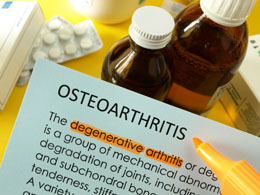A common disorder of the joints, osteoarthritis is known to affect about 27 million Americans, which include more women who are over 50 than men of the same age. This article gives you a brief insight into the major symptoms of osteoarthritis.

The ends of the bones in the joints are cushioned by cartilage. This cushion tends to deteriorate over time, becoming rough and causing irritation. As this process of wear down continues, it may result in bone rubbing on bone, which may eventually result in damaged bones and joint pain. This condition is referred to as osteoarthritis. It is also known as osteoarthrosis, or degenerative joint disease. This condition mainly affects the hips, knees and spine as these are the weight-bearing joints of the body. Joints in the fingers, thumbs, large toe and neck are also affected.
What Indicates Osteoarthritis?
# The main symptom of osteoarthritis is joint pain. This pain often aggravates on movements like walking as this puts weight and pressure on the joints. More often than not, this pain is accompanied by a certain degree of stiffness in the joints. Stiff joints may make it difficult for the sufferer to move.
# Most people with osteoarthritis experience pain and stiffness during the morning hours after waking up. The stiffness is usually short-lived and usually lasts for 30 minutes once the person starts moving around. Osteoarthritis is a deteriorating condition whose symptoms worsen with time. With times, the joints may become stiffer and harder, producing a grating or crackling sensation when moved. This occurs when bones rub over bones.
# The pain caused by osteoarthritis usually gets worse with movements, and gets better when the person rests. But as the condition progresses, being inactive for a while may worsen the pain and stiffness in the affected joints of the body.
# With time, joints may become tender to touch and become less flexible. In some people, joints may appear larger than normal. This may be due to bone spurs around the affected joints. These are extra bits of bone that grow on normal bone. Although these bony growths are referred to as "spurs" they are usually smooth and not sharp. However, they can cause pain or wear and tear if they press or rub on the surroundings tissues. Bone spurs usually occur in the spine, hips, knees, shoulders, and feet.
# Due to restricted mobility and joint pain, most people with osteoarthritis may develop weakness with time and suffer from muscle wasting as well.
What is the Treatment?
Osteoarthritis is a chronic condition that worsens with time, and has no cure. But its symptoms are manageable. The main goal of the treatment is to reduce pain, and maintain joint movement to help patients lead a normal life.
Medicines that are commonly prescribed to reduce the severity of osteoarthritis consist of acetaminophen (pain reliever), and non-steroidal anti-inflammatory drugs (NSAIDs) (for reducing pain and inflammation). The above drugs may not be able to help people with severe pain. For them, their doctor may prescribe narcotic medicines.
Apart from medicines, patients may also benefit by taking up dedicated exercise programs, following measures to reduce stress on joints, and using braces or shoe inserts. The best form of exercise to manage osteoarthritis is water aerobics. As it is a non-weight bearing exercise it does not strain the joints unlike other land workouts. Some foundations also offer classes where people are taught skills to manage the painful symptoms of osteoarthritis. In extreme cases, patients might require the aid of surgery which might involve procedures to realign bones or replace damaged joints with artificial joints.
There are a few self-care measures people with osteoarthritis can follow at home to make themselves comfortable. They must take rest, exercise as recommended, manage weight, and use heating pad to relieve stiffness and ice packs to reduce muscle spasms. OTC creams or ointments can also help in dealing with the pain for sometime. Also, using assistive devices like a walker or walking stick proves beneficial for most people.


 The ends of the bones in the joints are cushioned by cartilage. This cushion tends to deteriorate over time, becoming rough and causing irritation. As this process of wear down continues, it may result in bone rubbing on bone, which may eventually result in damaged bones and joint pain. This condition is referred to as osteoarthritis. It is also known as osteoarthrosis, or degenerative joint disease. This condition mainly affects the hips, knees and spine as these are the weight-bearing joints of the body. Joints in the fingers, thumbs, large toe and neck are also affected.
The ends of the bones in the joints are cushioned by cartilage. This cushion tends to deteriorate over time, becoming rough and causing irritation. As this process of wear down continues, it may result in bone rubbing on bone, which may eventually result in damaged bones and joint pain. This condition is referred to as osteoarthritis. It is also known as osteoarthrosis, or degenerative joint disease. This condition mainly affects the hips, knees and spine as these are the weight-bearing joints of the body. Joints in the fingers, thumbs, large toe and neck are also affected.